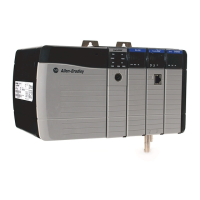Rockwell Automation Publication 1756-RM003N-EN-P - October 2011 639
Debug Instructions (BPT, TPT) Chapter 20
Tracepoints (TPT)
Trace points log data you select when a rung is true.
Operands:
Relay Ladder
Description: Tracepoints are programmed with the tracepoint output instruction (TPT).
When the inputs on a rung containing a TPT instruction are true, the
TPT instruction writes a trace entry to a trace display or log file.
You can trace many tags with the TPT instruction. However, the formatting
string can contain only 82 characters. Because the formatting string requires two
characters for each tag you want to trace, you cannot trace more than 41 tags with
a single TPT instruction. However, to separate tag data in your traces, you will
need to include spaces and other formatting, thus reducing the number of tags
that one TPT instruction can effectively trace to far
fewer than 41.
String Format
With the Format string in the tracepoint and breakpoint instructions, you can
control how the traced tags appear in the traces or breakpoint windows. The
format of the string is as shown here:
heading:(text)%(type)
where heading is a text string identifying the tracepoint or breakpoint, text is a
string describing the tag (or any other text you choose), and %(type) indicates the
format of the tag. You need one type indicator for each tag you are tracing with
the tracepoint or breakpoint instruction.
For example, you could format a tracepoint string as shown.
My tracepoint:Tag 1 = %e and Tag 2 = %d
The %e formats the first traced tag as double-precision float with an exponent,
and %d formats the second traced tag as a signed decimal integer.
Operand Type Format Description
Format String Tag A string that sets the formatting for the
trace reports (both on-screen and logged
to disk).
Trace This BOOL, SINT,
INT, DINT,
REAL
Tag The tag you want to trace.

